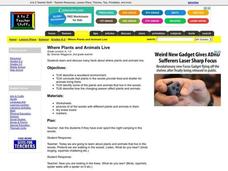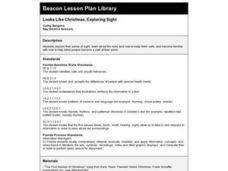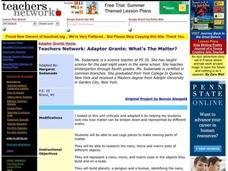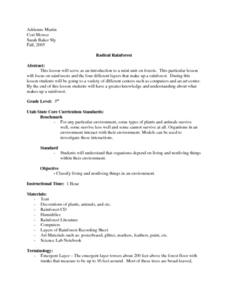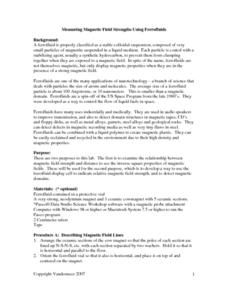Curated OER
Where Plants and Animals Live
Students explore and discuss facts about a woodland environment, the plants and animals that live there, and changing seasons in the woods. They conclude that plants in the woods provide food and shelter for animals living there.
Curated OER
Looks Like Christmas: Exploring Sight
Students participate in various hands-on activities to determine what life is like without the sense of sight.
Curated OER
A Tree Is More than a Street Name
Eighth graders discuss the role of trees as one of the most important natural resources. In groups, they examine how the forests nearby helped to shape their urban city. Using the internet, they research the use of the forest in early...
Curated OER
Plant Life of the Rainforest
Students study pictures of tropical rainforests and discuss its stratified character. Students then work with a partner to make a scale drawing of the rainforest strata.
Curated OER
Bird Feeders
Students create environmentally friendly art. In this visual arts lesson, students follow the provided instructions to create hanging bird feeders.
Curated OER
How Does Climate Affect Plant Growth?
First graders compare plant samples obtained from two different sites to explore how climate affects plants.
Curated OER
Populations and Ecosystems
Sixth graders examine the factors that influence the stability of ecosystems. They construct a miniature ecosystem in a jar that includes plants, small fish, and snails, record the population changes over a period of four weeks, and...
Curated OER
Tree Hunt
Students identify the common trees of Iowa and make observations while creating a key. In this tree hunt lesson, students write a letter to the Iowa Department of Natural Resources to receive a pamphlet of Common Trees of Iowa. Students...
Curated OER
Archimedes' Principle
Students examine the relationship between density and buoyancy. In this physics instructional activity students use Archimedes' Principle to complete calculations on buoyancy and a lab activity.
Curated OER
Mold
Students explore mold, the different types and the health risks that they pose. In this mycelium lesson students grow different molds and see which type of foods mold the fastest.
Curated OER
The Lesson: Cloning
Young scholars explore the concept of cloning. In this cloning lesson, students research reproduction, cloning, and ethic issues. Young scholars discuss their findings and write stories about extinct animals that are brought back to life.
Curated OER
Introduction to AP Chemistry
Students are introduced to concepts in an AP Chemistry class. They work together to complete experiments on different materials. They discuss the results of the experiments.
Curated OER
A "Real" Picuture of a Scientist
Students share their own stereotypes when they talk about scientists. In groups, they draw a picture of a scientist where they are working and the tools they most commonly used. Using the internet, they discover how archeolgists use the...
Curated OER
Genetic Engineering
Students examine the advantages and disadvantages of genetic engineering. In this genetics lesson students simulate the genetic engineering of a human insulin gene.
Curated OER
Taking Care of a Baby
Pupils are introduced to the basics of human development and the critical role of parents in taking care of a newborn.
Curated OER
Taking Care of a Baby
Young scholars explore the basics of human development and the critical role of parents in taking care of a newborn.
Curated OER
What's The Matter
Learners identify and describe the different stages of matter. In groups, the use lego pieces to represent the moving parts of matter. They use the internet to research the meanings of nano, micro and macro sizes. They also use the...
Curated OER
Exploring Texture In the Garden
Students explore the garden environment. In this garden environment lesson plan, students investigate the needs and parts of a plant. Students discover the differences between fruits and vegetables while creating their own garden.
Curated OER
Bouncing Balls
Students create a polymer ball in the lab. For this chemistry lesson, students identify the different properties of the polymer they created. They explain what type of chemical reaction took place.
Curated OER
The Sounds Of Nature
Second graders investigate the concept of sounds in nature. The sound of a coqui frog is used as an example. They identify species of frogs by listening to the sounds they make. Also, 2nd graders experience and identify other sounds of...
Curated OER
A Peek at the Past: Gradualism vs. Punctuated Equilibria
Learners consider two sets of simulated fossils (caminalcules) that are provided as cutouts. They arrange them on two time scales. One set produces a visual example of gradualism, the other shows punctuated equilibria.
Curated OER
The Great Continental Drift Mystery
Students stud the concept of Pangaea by using Wegener's clues to construct a map of the continents joined together. They determine how fossil distribution can be used to enhance the study of continental drift. They locate the...
Curated OER
Radical Rainforest
Third graders examine rainforests and the four different layers that make up a rainforest. They create an advertisement poster advertising a trip to the rainforest, including information concerning why people should visit, as well as,...
Curated OER
Measuring Magnetic Field Strengths Using Ferrofluids
High schoolers explore the field of nanotechnology by examining magnetic field strength in ferrofluids. They use probes attached to a computer program to determine the relationship between magnetic field strength and magnetic field lines.
Other popular searches
- Branches of Science
- Branches of Earth Science
- Major Branches of Science
- The Branches of Science
- 20 Branches of Science
- 12 Branches of Science
- Three Branches of Science
- All Branches of Science
- Earth Science Branches
- Branches of Biology Science
- Biological Science Branches
- Branches of Physical Science
